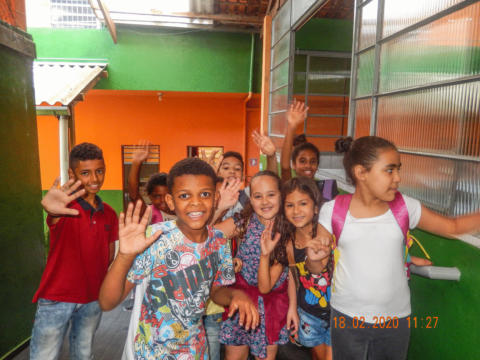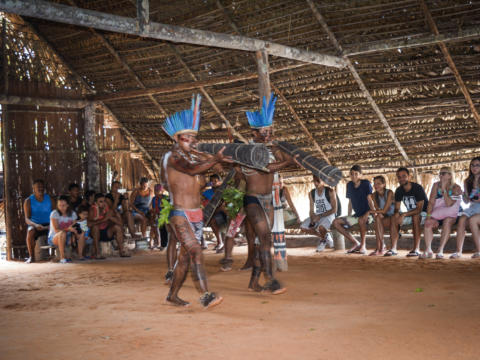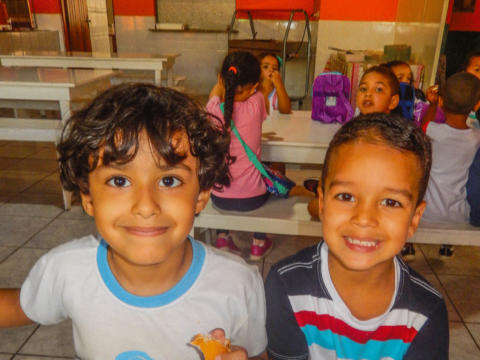Only 540€ per week!
English Teaching
Sao Paulo - Brazil
Meet kids and teens who are looking forward to learning English in Brazil!
Help local Brazilian teachers in their classroom with basic English skills and broaden the world view of children and adolescents from the outskirts of the city of São Paulo. You'll still have the chance to participate in planning while teaching English in fun and creative ways. This will help children acquire practical conversational skills, something that can be invaluable to them later in life!
Program Description
If you love teaching and being with children, then experiencing this Brazilian community as an assistant ESL teacher is something that you will really enjoy! English is one of the most commonly used languages for communication worldwide, and by teaching the local children, you are giving them an invaluable skill that will likely broaden their future opportunities.
Generally, public schools offer very few English classes throughout the week. Therefore, private language schools offer extra hours for those who need it and want it. These schools provide after school programs for school children (7-10 year olds), all the way up to young adults (11-14 year olds).
As an assistant Second Language English teacher, you will be teaching basic English to children through exchanging fun songs, group games and classroom activities. As such: you are required to show a level of proficiency in English, so as to effectively assist with the teaching; must be able to show extreme patience, since you will be engaged with young and intellectually growing students; and an ability to highly tolerate cultural differences.
A typical daily schedule will consist of breakfast early in the morning followed by three hours of teaching. An hour and a half of lunch-break proceeded by a couple more hours of work either in the afternoon or evening. You are more than welcome to bring your own teaching resources like books, traditional school supplies, comics or even electronic devices.
Aims & Objectives
- Inspire children to learn through creative teaching methods
- Improve local children’s educational prospects and widen their cultural interactions
- Gain invaluable and practical experience in teaching
- Assist local staff by providing an extra hand
Schedule
Monday to Friday
- Breakfast
- Assist teaching English at the center for approximately 3 hours
- Lunch
- Assist teaching English at the center for approximately 2 hours
- Dinner
Note: This schedule can be changed and/or amended depending on weather conditions, local conditions and unforeseen circumstances.
Participant Criteria & Requirements
Standard Requirements
Minimum age: –
Maximum age: –
Minimum English level: Basic
CRB required: On Signup
Passport copy required: No
Resume copy required: No
Required qualification: None
Additional Requirements
There are no further requirements for this program.
Additional Equipment
- You are more than welcome to bring teaching materials/resources for your class such as:
- Interesting board games
- English Books/Comics
- Color pencils/erasers
- Electronic devices
- And anything else you think will help!
Location
You will be located in São Paulo. It is a Brazilian municipality (south of the city), capital of the homonymous state and main financial, corporate and mercantile center of South America. It is the most populous city in Brazil, the American continent, Lusofonia and the entire southern hemisphere. Jardim Ângela/ Jardim Aracati is a district in the south of the municipality of São Paulo, . It is located on the banks of the Guarapiranga Dam, on the north bank.
About the Accommodation
You will be staying at the Good Shepherd Association in a simple participant’s house with the same standards as a home for families living in the community, you will sleep in beds and will share bedroom with others of same gender, sheets, blankets and pillows are provided, portable fans are provided in each room, consider bringing a mosquito net. You will receive daily assistance if necessary from employees and friends of the community. The accommodation is a safe and comfortable space.
You are expected to clean the kitchen after yourself as well as share the bathroom and bedroom cleaning.
Food Arrangements
All meals served at the institution will be typically Brazilian, including rice dishes, potatoes, beans, spaghetti, meat, sandwiches and vegetables.
Facilities
There are all the amenities you could need in neighboring neighborhoods, 3 miles away, (shopping center, banks, malls, markets, hospitals, shops, restaurants and more)
Activities & Events
No scheduled activities outside the program.
Sights & Surroundings
There are many things for you to do on the weekend. Museums, bars, cultural centers, restaurants, shopping places, cultural activities. There are nearby cities with beaches 90 kilometers away from the accommodation.
- Santos beach: A famous beach which is 3 hours from your accommodation, locals favorite place for the weekends and or holidays.
- Sao Paulo Capital: Attractions include famous parks, museums, theaters and a vibrate night life.
- Sao Paulo Interior where there are mountains and ecological walks and camping places.
- Hoppi Hari Park: very large park with endless mechanical games and rides
- Mirapuera Park where there are several museums of Afro and of modern art.
- Villa-Lobos State Park: Skating and cycling are possible here, bicycles and skates are rented.
- Embu das Artes town: A famous handicrafts fair market close by to Sao Paulo Available every Saturday and Sunday, you can find there very beautiful local handicrafts and arts, local food and more.
Transportation
From this location we do not provide free transport to other locations.
Quick Facts
Name: Federative Republic of Brazil
Population: 206 million
Capital: Brasilia
Language: Portuguese
Currency: Real (R$)
Time zone: BRT (UTC-2 to -5)
Country Information
Brazil is a huge country that possesses a great variety of natural wonders, interesting culture, a bustling nightlife, a diverse wildlife, beautiful beaches, wonderful festivals, scrumptious food, samba dancing, and much, much more.
Brazil comes from the Portuguese word for brazilwood, a tree that once grew plentifully along the Brazilian coast. Brazil is the fifth biggest country in the world and is bordered by all countries in South America except for Ecuador and Chile. This big country covers 47% of the continents land area. Brazil contains a major portion of the Amazon river basin and contains one third of Latin America’s population.
Climate
Brazil is something of an all-year round destination with temperatures rarely below 20°C, except for in the mountains and southern regions. The climate in Brazil varies from hot and dry along the coast to humid and sticky in the tropical rainforest of Amazon jungle. The summer in Brazil runs from December to February and the winter is from June to September. Since Brazil covers almost half of the South American continent the climate varies a lot between the regions.
North region
The north area of Brazil covers a great part of the Amazon basin. This area is very hot and humid, especially in the jungle. The median temperature here ranges from 24°C to 26°C with way higher temperatures during the summer. Rain here is not uncommon during summer and autumn.
Northeast region
The maximum temperature here is around 40°C, although the the average is between 20°C and 28°C. During winter months, mainly June and July, the minimum temperature is between 12°C and 16°C in the coastal regions.
Middle-West region
This region is well provided with rain. 70% of the rain occurs during November to March. It has a typical tropical climate, with a dry season during the winter. The minimum temperature ranges from 8°C to 18°C, but the temperature can go to negative during the coldest months. The summer is of course warmer, but wet, the temperature in this region ranges from 24°C to 26°C. The hottest month is September, which usually is hotter than 30°C everyday.
Southeast region
In the summer the temperature varies between 30°C to 32°C. January is the hottest month here and can be very humid. But in the winter it can get as cold as -4°C to 8°C and is usually very dry with a dry season of 2 to 6 months.
South region
The winter here is cold and the summer is warm. Here rain and maybe even storms is not uncommon during the summer. The annual median temperature is between 6°C and 12°C even though the thermometer frequently register temperatures around 0°C. The summer is warmer, with temperatures around 25°C. In the lower areas it can get even hotter than that.
Culture
The brazilian culture is one of the world’s most varied and diverse as it has been greatly influenced by Portuguese and African people, as well as other European countries like Italy, Germany and Spain. This diverse cultural background has helped boast many celebrations and festivals that have become known around the world. One of them is the colorful Carnival of Brazil which is an annual carnival held 51 days before Easter. The carnival is the most famous holiday here and has become an event of huge proportions. For almost a week festivities are intense, day and night, mainly in the bigger and coastal cities. They are wearing masks and colorful costumes and dance to the beat of drums and music. During this time shops can close down to join the parade and dance their way through the city till late evening.
Portuguese is the national “language” in Brazil, but it has it’s differences when compared with European Portuguese. This is because the Brazilian Portuguese has incorporated words and phrases from the African and Indigenous people. Brazil has over 180 Indigenous languages that are mostly spoken in rural areas.
Gastronomy
The food scene in Brazil is a culinary melting pot merging influences from all over the world. It varies a lot between the regions, they have their own way of cooking and their own traditional dishes. The brazilian people love to cook with their fresh fruit and vegetables like okra, coconuts corn and beans. Many national dishes contains beans, rice or manioc (cassava) flour. A very popular dish here contains just rice and beans. In variation to rice and beans, Brazilians also eat pasta dishes and of course, pizza, usually made in a wood-fire oven with a thin, flexible crust.
Feijoada is often described as the national dish here, especially in Rio de Janeiro, as other parts of Brazil have their own regional dishes. The dish contains black beans, a variety of salted pork or beef product, and at least two types of sausages and jerked beef. In some regions vegetable or banana is added to the stew at the end of the cooking. It is usually served with white rice and oranges on a saturday afternoon or for sunday lunch.
Transportation
Plane
In a large country like Brazil, travelling domestically by airplane is something to consider seriously as it can be just as affordable as travelling by long-distance bus. Brazil is the country with the second most airports in the world, so the network is vast. The main carriers which offer domestic flights are GOL and TAM airlines. If you plan to visit many cities, you can purchase a Brazil Airpass which offers you to go on 4 to 5 flights anywhere in its domestic network. The Airpass is only valid for 30 days and has to be purchased outside of the country.
Bus
The bus network in Brazil is extensive and the buses are quite comfortable, especially those that are used for long distance travel. The best service and vehicles will be found in the south. The buses stop for short breaks every few hours. City buses are usually pretty cheap and are strictly in town.
Train and Boat
Rail networks are very limited and the trains are often slow and not very comfortable. Travelling by boat is a lot more common in Brazil, at least in some specific parts of the country. In the Amazon basin the river is still the most important ‘road’.




